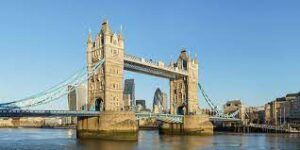Instruções:
Essas aulas de inglês são para alunos intermediários e avançados de inglês como segunda língua. Eles incluem “Ler”, “Ouvir” e “Escrever”. Basta seguir a lição respondendo às perguntas à medida que as encontra. Todas as vagas em negrito devem ser traduzidas para seu próprio idioma para ajudar na compreensão do novo vocabulário. 
1). Big Ben and The Palace of Westminster.
The Houses of Parliament and Elizabeth Tower, commonly called Big Ben, are among London’s most iconic landmarks and must-see London attractions. Technically, Big Ben is the name given to the massive bell inside the clock tower, which weighs more than 13 tons (13,760 kg). The clock tower looks spectacular at night when the four clock faces are illuminated.
The Palace of Westminster was destroyed by fire in 1834. In 1844, it was decided the new buildings for the Houses of Parliament should include a tower and a clock. 
A massive bell was required and the first attempt cracked irreparably. The metal was melted down and the bell recast in Whitechapel in 1858.
Big Ben first rang across Westminster on 31 May 1859. A short time later, in September 1859, Big Ben cracked. A lighter hammer was fitted and the bell rotated to present an undamaged section to the hammer. This is the bell as we hear it today.
2). Camden Town
Camden Town is famed for its market, a warren of fashion and curiosities by the Regent’s Canal. A haven of counter culture, the area is popular with tourists, teenagers and punks. The thriving nightlife scene includes live music in alternative clubs and old-school pubs, and major stars playing at the Jazz Cafe and the Roundhouse. Cafes bustle during the day. Nearby Regent’s Park has formal gardens and the London Zoo.
Camden Town has been a residential area since the 1790s. But it was only the development of the Grand Union Canal and the improved railway transport that turned it into a bustling part of London. 
Today, visitors and locals gather here to hunt for treasures in Camden’s markets, stroll by Regent’s Canal, sample cuisine from around the world and listen to live music. Many famous people, including Dylan Thomas, Walter Sickert and Amy Winehouse, have called Camden home.
Camden has a labyrinth of open-air markets and other stores that will keep even the keenest shoppers busy.
- Check out Camden Lock Market and browse the stalls for crafts, books, clothing, jewellery and fast food.
- Camden Lock Village sells clothing and accessories, as well as a range of unusual items.
- Originally named Buck Street, Camden Market sells fashion for all tastes.
- Head to Inverness Street Market, where a few of the original fruit stands remain but most have been taken over by footwear and souvenir stalls.
- Find a mix of permanent shops and stalls selling household items, antiques, alternative clothing and food at Stables Market.
- Go on a shopping spree on Camden High Street, which is home to big fashion brands and vintage clothing stores.
3). Museums
There are many museums in London and most are free to enter.
No visit to London is complete without checking out its fantastic selection of museums and galleries. Here are 50 of the best (in no particular order), from big hitters to quirkier specialist museums. 
You’ll see there’s one to suit every interest and many of them are free to visit – take your pick, then use the London attractions map to work out how to get there and which one to visit next. Use this link to find out more: 50 Museums
4). Covent Garden
A shopping and entertainment hub in London’s West End, Covent Garden centres on the elegant, car-free Piazza, home to fashion stores, craft stalls at the Apple Market, and the Royal Opera House. Street entertainers perform by 17th-century St. Paul’s Church, and the London Transport Museum houses vintage vehicles. Upscale restaurants serve European cuisines, and nearby theatres draw crowds for plays and musicals.  Set in London’s West End, Covent Garden is a vibrant, must-see destination for anyone who enjoys shopping, theatre, restaurants, bars, history and culture. Things to see in and around Covent Garden include the London Transport Museum, the Royal Opera House, Somerset House and Covent Garden Market. TRIP ADVISOR
Set in London’s West End, Covent Garden is a vibrant, must-see destination for anyone who enjoys shopping, theatre, restaurants, bars, history and culture. Things to see in and around Covent Garden include the London Transport Museum, the Royal Opera House, Somerset House and Covent Garden Market. TRIP ADVISOR
5). London Eye
The London Eye, or the Millennium Wheel, is a cantilevered observation wheel on the South Bank of the River Thames in London. It is Europe’s tallest cantilevered observation wheel, and is the most popular paid tourist attraction in the United Kingdom with over 3 million visitors annually. A trip on the London Eye is truly captivating, a ‘must-do’ and has been London’s number one visitor experience for over a decade.  Elegantly rotating over the River Thames and less than a five minute stroll from Waterloo station along the beautiful Southbank. Step into your capsule and feel the exhilaration as you rise up over the Thames. Come face to face with the Houses of Parliament and Big Ben, before soaring above them – up to 135 metres on the world’s tallest cantilevered observation wheel. There are mesmerising 360-degree views of the capital laid out before you – London’s most famous landmarks and up to 40km out of the city to Windsor Castle on a clear day. TRIP ADVISOR
Elegantly rotating over the River Thames and less than a five minute stroll from Waterloo station along the beautiful Southbank. Step into your capsule and feel the exhilaration as you rise up over the Thames. Come face to face with the Houses of Parliament and Big Ben, before soaring above them – up to 135 metres on the world’s tallest cantilevered observation wheel. There are mesmerising 360-degree views of the capital laid out before you – London’s most famous landmarks and up to 40km out of the city to Windsor Castle on a clear day. TRIP ADVISOR
6). Little Venice
Little Venice is a district in West London, England, around the junction of the Paddington Arm of the Grand Union Canal, the Regent’s Canal, and the entrance to Paddington Basin. The junction forms a triangular shape basin. Although not far from congested roads and the commuters streaming out of Paddington Station, Little Venice is an oasis of peace and tranquillity. It’s thought to have been so-named by the poet, Robert Browning. 
Dozens of narrowboats, day trip boats and water cafés line this calm stretch where the Grand Union Canal meets the Regent’s Canal. The famous Little Venice mansions provide a stunning backdrop. And the triangular pool, complete with willow tree, is home to several floating businesses such as the Waterside Cafe, London Waterbus, a floating art gallery and a hotel boat.
Check out our welcome station at Little Venice – a place to chat to our friendly volunteers and pick up some information about the local area. Our welcome station is usually open on Saturdays and Sundays between 10.30am and 3.00pm, but this can change. THE CANAL TRUST
7). Buckingham Palace
Buckingham Palace is a London royal residence and the administrative headquarters of the monarch of the United Kingdom. Located in the City of Westminster, the palace is often at the centre of state occasions and royal hospitality. During the summer and on selected dates from November to December and at Easter, visitors can tour the 19 State Rooms, which form the heart of the Palace. These magnificent rooms are decorated with some of the greatest treasures from the Royal Collection, including paintings by Rembrandt, Rubens and Canaletto. Read about the top 10 things to see on a Buckingham Palace tour. 
The spectacular exhibition, alongside the summer opening of Buckingham Palace, includes an unprecedented display of a number of Queen Elizabeth II’s portraits and personal possessions, marking the Platinum Jubilee of the monarch’s accession to the throne in 1952.
The Royal Mews and The Queen’s Gallery are part of the Buckingham Palace site, but have their own visitor entrances and so can be visited separately. Or The Royal Mews can be visited as part of a combined ticket. Both venues are open for most of the year, including when the palace itself is closed.
Try to time your visit to see Changing the Guard, a popular free event which takes place outside Buckingham Palace on certain days from 10.45am and lasts around 45 minutes, with the actual handover taking place at 11am. Be sure to arrive early to secure a spot with a good view. BUCKINGHAM PALACE
8). SHOPPING

Shopping in London is hard to beat – from areas full of flagship stores, to cobbled courtyards showcasing local designers, these are some of the best places to shop in London.
So, put on some comfy shoes and prepare to discover some of the best shops in London with our guide to the capital’s best shopping areas.
The main shopping ares are OXFORD STREET, REGENT STREET, ST. JAMES, BOND STREET, MAYFAIR, CARNABY STREET, HARRODS, COVENT GARDEN, THE SEVEN DIALS, THE KINGS ROAD, KNIGHTSBRIDGE, GREENWICH, CAMDEN to many to list here. MAP OF SHOPPING PLACES
9). OUR PARKS & GARDENS
In London there are many beautiful Victorian parks and gardens. Here is a map and list of all of the parks and gardens in London. MAP OF PARKS & GARDENS
10). TOWER BRIDGE & TOWER OF LONDON
Tower Bridge, movable bridge of the double-leaf bascule (drawbridge) type that spans the River Thames between the Greater London boroughs of Tower Hamlets and Southwark. It is a distinct landmark that aesthetically complements the Tower of London, which it adjoins. The bridge was completed in 1894. 
When it was built, Tower Bridge was the largest and most sophisticated bascule bridge ever completed (‘bascule’ comes from the French word for ‘seesaw‘). These bascules were operated by hydraulics, using steam to power the enormous pumping engines. The energy created was stored in six massive accumulators, meaning that as soon as power was required to lift the Bridge, it was always readily available. The accumulators fed the driving engines, which drove the bascules up and down. Despite the complexity of the system, the bascules only took about a minute to raise to their maximum angle of 86 degrees.
Today, the bascules are still operated by hydraulic power, but since 1976 they have been driven by oil and electricity rather than steam. The original pumping engines, accumulators and boilers are now on display within Tower Bridge’s Engine Rooms.
Tower of London, by name the Tower, royal fortress and London landmark. Its buildings and grounds served historically as a royal palace, a political prison, a place of execution, an arsenal, a royal mint, a menagerie, and a public records office. It is located on the north bank of the River Thames, in the extreme western portion of the borough of Tower Hamlets, on the border with the central City of London.
VIDEO:
[rafflepress id=”1″]


